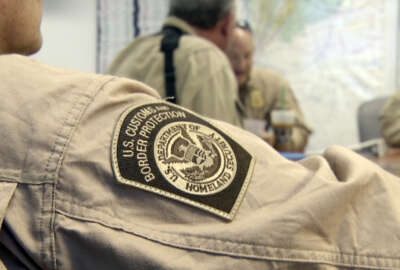CBP updates how it treats business information in anti-dumping investigations
CBP has taken steps to better balance transparency and privacy when it comes to what are known as Enforce and Protect Act administrative proceedings.
Customs and Border Protection (CBP) has taken steps to better balance transparency and privacy when it comes to what are known as Enforce and Protect Act administrative proceedings. The new procedures let parties involved in anti-dumping and duty cases see information that is otherwise protected. To hear how it works, the Federal Drive with Tom Temin spoke with the Executive Director of CBP’s Regulations and Ruling Directorate, Alice Kipel.
Correction: At the end of the interview, Alice Kipel is misidentified as Alex Kipel.
Interview Transcript:
Tom Temin Well, this type of procedure happens in other contexts and other agencies where there’s proprietary information that some people can see, and rest of the world can’t. And so, I think there’s wide applicability maybe for what you’re doing. Tell us what you are doing?
Alice Kipel Sure. As you mentioned, we’ve got the enforce and protect act proceedings that we started running in 2016, after the trade facilitation and Trade Enforcement Act was signed into law in February, and we collect and are provided a lot of confidential information in these proceedings, which look into the question of whether an alleged evader of anti-dumping or countervailing duties is actually evading the payment of duties using false information or materially omitting information. And up until recently, what we did was summarize confidential information that was provided to us in public documents and in public versions. But now that we’ve instituted an administrative protective order procedure, we are able to share with representatives of parties to the investigation, so that would be the party who brought the allegation alleging that there was duty evasion, as well as the importers who are alleged to be evaders. And we are able to share with their essentially with their counsel, the confidential information that either we have collected, or that’s been provided to us. And so, it’s a limited sharing, but it enhances the transparency of the proceedings, and allows for a more robust argumentation on the part of all parties as to what is the data actually showing us because they can now see the confidential information. Obviously, they are not allowed to share it with their clients. They’re not allowed to share it with others lots of restrictions. And as you mentioned, this is a procedure that is used, for example of the Department of Commerce and anti-dumping and countervailing duty proceedings at the US International Trade Commission and anti-dumping and countervailing duty proceedings, as well as proceedings under Section 337 of the Tariff Act of 1930. So, we’re really pleased with this development.
Tom Temin And the innovation here then seems to be the administrative protective order. This is something that is new here, and how did that come to be in existence?
Alice Kipel As I mentioned, it is a tool that’s used in other agencies. With respect to the EAPA proceedings, the statutory authorities that we were given, did not provide for an administrative protective order. So, we were relying on the public summaries. Recently, the US Court of Appeals for the Federal Circuit in a decision which we call the royal brush decision, indicated that CBP has the inherent authority to issue administrative protective orders in these proceedings. So as a result, we have amended our regulations to allow for issuance of administrative protective orders. And we are issuing administrative protective orders. And so, parties are now on notice that if they are going to provide confidential information during the course of an EAPA proceeding, they will have to do so under an administrative protective order that the representatives or counsel for the parties to the investigation will have access to that information. We have a handbook that we’ve issued, that lays out in great detail what the administrative protective order procedures are. And we are now using these administrative protective orders in EAPA cases as we go forward.
Tom Temin We’re speaking with Alice Kipel. She is executive director of the regulations and rulings Directorate at Customs and Border Protection. And just give us a sense of how often these cases come up each year. What’s your workload look like in dealing with these allegations of duty evasion and so on.
Alice Kipel In my directorate, what we handle are what we call the Administrative Review proceedings in EAPA cases. So, I’ll take a step back. The cases typically begin with allegations. We have the trade remedy law enforcement Directorate at the office of trade at US Customs and Border Protection that will investigate the allegations and they may or may not actually initiate a formal investigation. They will then conduct a very robust proceeding, where they issue requests for information, they may conduct onsite verifications of the data that they are provided. And they will reach a determination as to whether or not there was evasion. And if a party is unsatisfied with that determination, they can seek administrative review before regulations and rulings. And then we will assuming it’s timely and properly filed, we have 60 days in which to conduct an administrative review, where we conduct what’s called the de novo procedure. So, we will look at the entire record and reach a determination as to whether there’s substantial evidence to support a finding of evasion or a finding of no evasion. And thereafter parties, if they’re not satisfied with our decisions can seek judicial review with the US Court of International Trade, and then ultimately at the Court of Appeals for the Federal Circuit. So, we in regulations, and rulings, see somewhere between 10 and 15 administrative reviews each year, in the trade remedy law enforcement directorate, I’ve would estimate that somewhere between 50 and 100, not each allegation is going to turn into an investigation, or it may not turn into an investigation immediately. But that’s the volume that we’re talking about. And the records are 1000s and 1000s and 1000s of pages long. So, they are very complex proceedings. And we thus far both at trade remedy law enforcement Directorate and regulations and rulings have always issued our decisions within the statutory timeframes that are allowed. So, we’re very proud of that track record.
Tom Temin How do these cases come to light? In other words, how does someone get to unload a shipment? If they haven’t paid the duties on it?
Alice Kipel It’s two different questions how they come to light as competitors, obviously keep an eye on what their competitors are doing. So most often the allegations are going to come from either the US manufacturer of a light product or by frankly, sometimes from a competitor importer, who thinks that someone Gee, I don’t see how they could possibly be charging that price. It’s way too low, or Gee, I’m not so sure. They claim that the goods are manufactured in, say Vietnam, but we’re not seeing a lot of manufacturing operations in Vietnam for this product. So maybe the goods are really from China and covered by an existing anti-dumping or countervailing duty order. So that’s typically from whom we see allegations. And then the other part of the question, I believe, was how do we wrap our heads around getting the information that we need, and we’ll issue questionnaires and request for information to manufacturers, importers, anybody from whom we think we might get information, sometimes it might be foreign governments might provide us information, it just depends on the circumstances, and the nature of the allegation, because it could be that to escape or to should I say get in under the radar, for example, we might see someone misclassifying their goods. So, it’s not going to be readily apparent from the documentation that’s filed with CBP, that the goods might be subject to an anti-dumping or countervailing duty order because they’re being classified or say, as other parts as opposed to say, pipe or something like that. Or perhaps again, country of origin, not so sure, maybe a misrepresentation of that type of scenario. And so, the allegations obviously help us because then we take a look at what documentation we have and do various due diligence and research.
Tom Temin Do corporate whistleblowers ever chime in? Hey, we’re telling you guys, that’s from Vietnam, but I know it’s from China. And is there any key tam availability for this?
Alice Kipel So that would be separate and apart. So, there are a lot of tools that we have in our toolbox. Key tam being a separate tool, the EAPA investigations were really designed to provide more transparency and accountability. So that when we get an allegation, CBP is under a certain obligation to under the EAPA to take certain steps, as opposed to situations where we may get to start what we call a regular E allegation where there it could come from any number of sources, including a whistleblower. And in those situations where we’re not talking about a formal EAPA proceeding. We have a variety of law enforcement tools available to us. And it may not be as transparent, but EAPA was designed for transparency.
Copyright © 2024 Federal News Network. All rights reserved. This website is not intended for users located within the European Economic Area.
Tom Temin is host of the Federal Drive and has been providing insight on federal technology and management issues for more than 30 years.
Follow @tteminWFED






